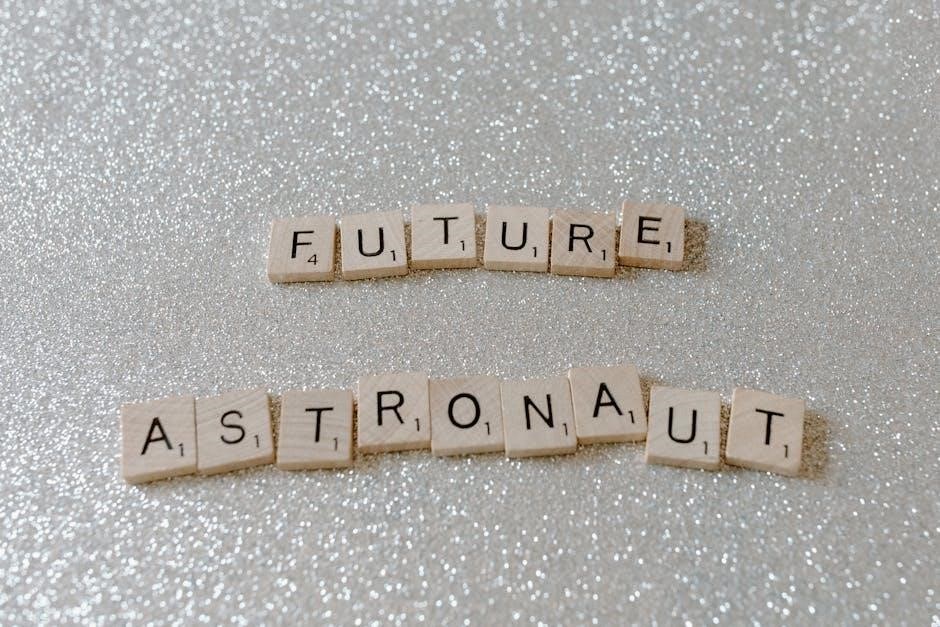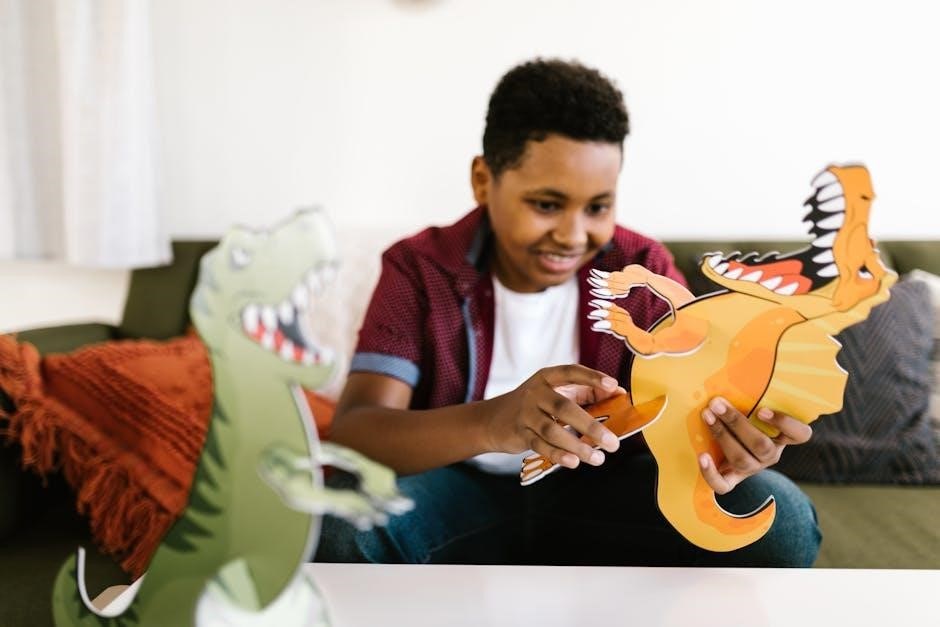solar system for kids pdf

Explore the Solar System‚ a fascinating collection of planets‚ moons‚ asteroids‚ and comets orbiting the Sun. Discover fun facts and activities in educational PDF resources designed for kids!
What is the Solar System?
The Solar System is a collection of celestial objects that orbit around the Sun‚ including eight main planets‚ dwarf planets‚ moons‚ asteroids‚ comets‚ and other smaller bodies. Formed about 4.5 billion years ago‚ it is a vast and fascinating place that sparks curiosity and wonder. The Sun‚ as the central star‚ provides light and heat‚ while the planets vary greatly in size‚ composition‚ and temperature. From rocky worlds like Earth to gas giants like Jupiter‚ the Solar System offers endless opportunities for exploration and learning. Educational resources‚ such as PDF guides and activities‚ make it fun and engaging for kids to discover its many secrets.
The Sun and the Planets
The Sun is the heart of our Solar System‚ providing light and heat to the planets. It is the largest object in the system‚ with the eight planets orbiting around it. The planets are divided into two groups: the rocky‚ terrestrial planets (Mercury‚ Venus‚ Earth‚ and Mars) and the gas and ice giants (Jupiter‚ Saturn‚ Uranus‚ and Neptune). Each planet is unique‚ with different sizes‚ temperatures‚ and features. For example‚ Jupiter is the largest planet‚ while Mercury is the smallest and closest to the Sun. Educational PDF resources for kids often include fun facts‚ images‚ and activities to help them learn about the Sun and the planets in an engaging way;
A Brief History of Solar System Exploration
The study of the Solar System has fascinated humans for centuries‚ beginning with ancient observations of the night sky. Early astronomers like Galileo used telescopes to explore planets and moons. In the 20th century‚ space agencies like NASA launched missions to study the Solar System in detail. Probes like Voyager and New Horizons revealed stunning images and data about planets and their moons. These discoveries have been compiled into educational resources‚ including PDFs and interactive activities‚ to help kids learn about the Solar System’s history and its many mysteries. This wealth of information inspires young minds to explore and understand our cosmic neighborhood.

Key Features of the Solar System
The Solar System is characterized by its unique features‚ including eight planets‚ dwarf planets‚ moons‚ asteroids‚ comets‚ and the Kuiper Belt. The Sun is the central star‚ providing light and heat. Planets vary in size‚ composition‚ and temperature‚ with Mercury being the closest and Neptune the farthest. The Solar System also includes natural satellites‚ like the Moon‚ and smaller bodies like asteroids and comets. These elements‚ along with the vast distances between them‚ make the Solar System a complex and fascinating place to study. Educational PDFs for kids offer engaging ways to learn about these features through fun facts‚ diagrams‚ and activities‚ helping young learners grasp the scale and diversity of our cosmic neighborhood.

The Planets of the Solar System
Discover the eight planets: Mercury‚ Venus‚ Earth‚ Mars‚ Jupiter‚ Saturn‚ Uranus‚ and Neptune. Each planet has unique features‚ making our Solar System an exciting place to explore!
Mercury: The Closest Planet to the Sun
Mercury is the smallest planet in our Solar System and the closest to the Sun. It orbits the Sun very quickly‚ taking just 88 days to complete one rotation. Mercury has no moons and is covered in craters‚ making it look similar to the Moon. Its surface temperature can be extremely hot during the day but very cold at night because it has no atmosphere to regulate heat. Despite its small size‚ Mercury is fascinating to scientists who study its unique orbit and composition.
- Mercury is the fastest-moving planet in the Solar System.
- It has no atmosphere‚ so it cannot support life.
- Mercury is one of the densest planets‚ meaning it has a lot of mass for its size.
Learning about Mercury helps kids understand how diverse the planets are!
Venus: The Hottest Planet
Venus is the second planet from the Sun and the hottest in the Solar System. Its thick atmosphere‚ mostly carbon dioxide‚ traps heat‚ creating a strong greenhouse effect. This makes Venus’s surface temperature reach up to 462°C (863°F)‚ hotter than Mercury‚ which is closer to the Sun. Venus is often called Earth’s twin due to their similar size and mass‚ but the similarities end there; Unlike Earth‚ Venus has no moons and rotates very slowly‚ taking 243 Earth days to complete one rotation. Its surface is hidden by thick clouds of sulfuric acid and droplets of water.
- Venus is the brightest planet in the sky due to its thick clouds reflecting sunlight.
- It has numerous volcanoes‚ with over 1‚600 major volcanoes identified.
- The extreme heat and crushing pressure on Venus make it one of the most inhospitable places in the Solar System.
Learning about Venus helps kids explore the diversity of planetary environments!
Earth: Our Home Planet
Earth is the only planet in the Solar System known to support life. It has a perfect atmosphere for living things‚ with just the right amount of oxygen and water. Earth’s surface is 71% water‚ and it’s home to mountains‚ oceans‚ forests‚ and deserts. Our planet rotates on its axis‚ creating day and night‚ and tilts to bring us seasons. Earth is the third planet from the Sun and orbits it every 365.25 days.
- Earth’s diversity supports millions of species‚ including humans!
- The ozone layer protects us from harmful sunlight.
- Earth’s magnetic field shields us from space particles.
Learning about Earth helps kids appreciate our amazing home planet!
Mars: The Red Planet
Mars is often called the Red Planet because of its rusty red appearance. It’s the fourth planet from the Sun and is much smaller than Earth. Mars has two moons and is known for its rocky surface‚ deep valleys‚ and the tallest volcano in the Solar System‚ Olympus Mons. Scientists believe Mars might have had water and even life a long time ago.
- Mars has the longest valley in the Solar System‚ Valles Marineris;
- The planet’s thin atmosphere makes it very cold at night.
- Mars is a favorite target for space exploration and future human visits.
Learning about Mars sparks curiosity about potential life beyond Earth!

Jupiter: The Largest Planet
Jupiter is the largest planet in our Solar System‚ more than 1‚300 times bigger than Earth! It’s a gas giant‚ meaning it’s mostly made of air-like gases. Jupiter is famous for its colorful stripes and the Great Red Spot‚ a giant storm that has lasted for centuries; The planet has dozens of moons‚ with Io‚ Europa‚ Ganymede‚ and Callisto being the largest.
- Jupiter’s magnetic field is so strong it traps asteroids‚ forming a ring around it.
- The planet’s fast rotation creates strong winds and vibrant cloud patterns.
- Jupiter is often called a “failed star” because it could have become one with more mass.
Learning about Jupiter’s size and storms inspires awe and curiosity about the universe!
Saturn: The Planet with Rings
Saturn is one of the most stunning planets in the Solar System‚ famous for its beautiful rings made of ice and rock. These rings stretch out for hundreds of thousands of miles but are incredibly thin. Saturn is a gas giant‚ mostly made of hydrogen and helium. It has at least 83 moons‚ with Titan and Enceladus being the largest. Titan has lakes of liquid methane‚ while Enceladus has geysers of water.
- Saturn’s rings are thought to be pieces of moons that never fully formed.
- The planet’s strong winds create massive storm clouds.
- Saturn is less dense than water‚ meaning it could float if placed in a giant bathtub!
Saturn’s unique features make it a favorite for kids to explore and learn about.
Uranus: The Tilted Planet
Uranus is a unique ice giant planet known for its dramatic tilt‚ rotating almost on its side. This unusual tilt causes extreme seasons‚ making it one of the most fascinating planets.
- Its blue-green color comes from methane in the atmosphere‚ which absorbs red light.
- Uranus has a thick atmosphere mostly made of hydrogen‚ helium‚ and methane.
- It has a system of rings and moons‚ with Miranda being the most interesting moon due to its strange‚ cliff-lined terrain.
Uranus is much colder than Earth and has strong winds that create massive storm systems. Its tilt and composition make it a fascinating subject for kids to explore and learn about in Solar System PDF resources.
Neptune: The Farthest Planet
Neptune‚ the eighth and farthest planet from the Sun‚ is a stunning ice giant with deep blue color. Its distance makes it very cold‚ with freezing temperatures.
- Neptune has strong winds creating massive storm systems‚ including the Great Dark Spot‚ similar to Jupiter’s Red Spot.
- It has a few thin rings and several moons‚ with Triton being the largest‚ featuring geysers that shoot ice particles into space.
- Neptune was discovered in 1846 and is much smaller than Uranus but has a more active atmosphere.
Neptune’s unique features and extreme conditions make it an exciting topic for kids to explore in educational Solar System PDFs and activities.

Other Components of the Solar System
Explore the Solar System’s fascinating components beyond planets‚ including moons‚ dwarf planets‚ asteroids‚ comets‚ and the Kuiper Belt‚ perfect for kids to learn in PDFs.
Moons: Natural Satellites of the Planets
Moons are natural satellites that orbit planets in our Solar System. The Moon‚ Earth’s only satellite‚ is the largest relative to its planet. Jupiter has the most moons‚ with over 80! Some moons‚ like Jupiter’s Ganymede‚ are bigger than Mercury. Saturn’s moons‚ such as Titan‚ have unique features like lakes of liquid methane. Mars has two small moons‚ Phobos and Deimos‚ while Venus and Mercury have none. Moons vary greatly in size and composition‚ from rocky bodies to icy worlds. Learning about moons helps kids understand planetary systems and celestial mechanics. Educational PDFs and activities make studying moons fun and engaging for young learners!
Dwarf Planets: Pluto and Beyond
Dwarf planets are small‚ rocky or icy bodies that orbit the Sun. Pluto‚ once classified as the ninth planet‚ is the most famous dwarf planet. Others include Eris‚ Ceres‚ Haumea‚ and Makemake. These celestial bodies are much smaller than planets and have not cleared their orbits of other objects. Pluto‚ located in the Kuiper Belt‚ has five moons of its own. Dwarf planets offer insights into the early formation of the Solar System. Educational resources‚ like PDFs and activities‚ help kids learn about these mysterious worlds‚ sparking curiosity about space and astronomy. Studying dwarf planets encourages young learners to explore the vastness and complexity of our cosmic neighborhood!
Asteroids: Small Rocky Bodies
Asteroids are small‚ rocky objects that orbit the Sun‚ mostly found in the asteroid belt between Mars and Jupiter. These remnants from the Solar System’s formation are often irregularly shaped and vary in size. Some asteroids are just a few meters wide‚ while others‚ like Ceres‚ are hundreds of kilometers across. Ceres is the largest asteroid and is now classified as a dwarf planet. Asteroids provide valuable insights into the early Solar System’s composition. Educational PDFs for kids include fun facts‚ quizzes‚ and activities about asteroids‚ helping young learners understand their role in space and how they differ from planets. These resources make learning about asteroids engaging and accessible for children!
Comets: Icy Visitors from Space
Comets are icy bodies that orbit the Sun‚ often called “icy visitors” because they originate from the outer Solar System. When a comet approaches the Sun‚ its ice melts‚ creating a bright tail of gas and dust; Comets are thought to have delivered water and organic materials to Earth long ago. They are mostly found in the Kuiper Belt and Oort Cloud. Educational PDFs for kids include colorful illustrations and fun facts about comets‚ such as their glowing tails and how they differ from asteroids. These resources help children learn about comets in an engaging way‚ making space exploration exciting and accessible for young minds!
The Kuiper Belt: A Region of Small Bodies
The Kuiper Belt is a vast region beyond Neptune filled with small‚ icy bodies like dwarf planets‚ asteroids‚ and comets. These remnants from the Solar System’s formation are too small to be planets. The Kuiper Belt is a “reservoir” for short-period comets‚ which originate from here. Educational PDFs for kids explain how these icy bodies differ from asteroids and their role in the Solar System’s history. Activities like creating a Kuiper Belt model help children visualize this distant region. Learning about the Kuiper Belt sparks curiosity about space and its many mysteries‚ making it a fun and educational topic for young explorers to discover!

Learning About the Solar System
Discover the Solar System through fun‚ interactive PDF resources‚ educational activities‚ and engaging games. These tools make learning about planets‚ orbits‚ and space exploration exciting for kids of all ages!
Fun Facts for Kids
Did you know the Solar System is about 4.5 billion years old? It includes eight planets‚ moons‚ asteroids‚ and comets! Mercury is the closest planet to the Sun‚ while Neptune is the farthest. Venus is the hottest planet‚ and Jupiter is the largest. Earth is our home‚ and Mars is known as the Red Planet. Saturn’s rings are made of ice and rock. Uranus spins on its side‚ and Neptune has the strongest winds; Moons orbit planets‚ and some are even bigger than the planets they circle! Asteroids and comets are like leftover building blocks of the Solar System. Learning these fun facts makes exploring the cosmos exciting for kids of all ages!
- Mercury is the fastest-orbiting planet.
- Venus shines brighter than any star.
- Mars has the tallest volcano in the Solar System.
- Jupiter’s Great Red Spot is a giant storm.
- Saturn’s rings stretch across 175‚000 miles!
These cool facts and more can be found in fun‚ educational Solar System PDFs designed just for kids!

Educational Activities and Projects
Engage kids with hands-on activities to learn about the Solar System! Create a scale model using different materials to show planet sizes and distances. Conduct a scavenger hunt with Solar System-themed items or organize a craft session where kids draw or paint their favorite planets. Interactive projects like building a solar system mobile or diorama help visualize orbits and relationships. Use printable worksheets and coloring pages from educational PDFs to reinforce learning. STEM-based activities‚ such as simulating planetary orbits or making comet models‚ encourage creativity and curiosity. These projects make learning about the Solar System fun and interactive for kids of all ages!
- Create a Solar System model with clay or paper plates.
- Plan a scavenger hunt with planet-themed clues.
- Draw or paint planetary landscapes.
- Build a mobile showing planetary orbits.
- Use STEM kits to create comet or asteroid models.
These activities‚ paired with educational resources‚ help kids explore and understand the Solar System in an engaging way!
Interactive Games and Quizzes
Make learning about the Solar System exciting with interactive games and quizzes! Kids can test their knowledge with fun online quizzes or printable worksheet challenges. Create a “Planetary Matching Game” where kids match planet names with their descriptions or images. Use crosswords or word searches featuring Solar System vocabulary to make learning engaging. Interactive bingo games with planet facts are also a hit. These activities‚ available in educational PDFs‚ help reinforce concepts while keeping kids entertained and eager to learn more about space!
- Planet trivia quizzes to test knowledge.
- Interactive matching games for planet facts.
- Word searches with Solar System terms.
- Bingo games featuring planetary details.
These fun activities make learning about the Solar System an enjoyable experience for kids of all ages!
Printable Worksheets and Coloring Pages
Engage kids with printable worksheets and coloring pages that make learning about the Solar System fun! These resources‚ available in PDF format‚ include planet labeling exercises‚ crossword puzzles‚ and creative coloring sheets. Kids can color the planets‚ draw their orbits‚ or match planet names with their descriptions; Worksheets also cover fun facts‚ such as the largest planet or the closest to the Sun. Printable activities like “Planet Scavenger Hunts” or “Solar System Sequencing” help reinforce learning. Coloring pages featuring Mercury‚ Venus‚ Earth‚ Mars‚ Jupiter‚ Saturn‚ Uranus‚ and Neptune inspire creativity while teaching kids about our cosmic neighborhood. These tools are perfect for homeschooling or classroom use‚ making learning interactive and enjoyable!
- Planet labeling and coloring sheets.
- Fun facts and trivia worksheets.
- Word searches and crossword puzzles.
- Planet sequencing activities.
These resources are designed to make learning about the Solar System a fun and creative experience for kids of all ages!
Free Solar System PDF Resources
Discover a wide range of free Solar System PDF resources designed for kids! These educational materials include printable mini-books‚ posters‚ and activity sheets. Perfect for homeschooling or classroom activities‚ these PDFs feature fun facts‚ colorful illustrations‚ and interactive exercises. Kids can explore planet profiles‚ Solar System diagrams‚ and quizzes to test their knowledge. Many resources are designed for different age groups‚ from kindergarten to grade 6‚ ensuring learning is accessible and engaging. Download these free PDFs to create a comprehensive and interactive Solar System learning experience for kids!
- Planet fact cards for each planet in the Solar System.
- Colorful posters to decorate learning spaces.
- Interactive worksheets and quizzes.
- Fun puzzles and word searches.
These resources are a great way to inspire curiosity and learning about our cosmic neighborhood!

Engaging Kids with the Solar System
Spark curiosity and creativity with DIY Solar System models‚ space-themed crafts‚ and interactive games. These activities make learning fun and inspire kids to explore the cosmos!
DIY Solar System Models
Creating DIY Solar System models is a fun and educational activity for kids! Use materials like Styrofoam balls‚ paint‚ and cardboard to craft planets and their orbits. Start by painting the Sun and arranging the planets according to their relative sizes and distances. Add details like Saturn’s rings or Jupiter’s Great Red Spot. For a scale model‚ consider the vast distances between planets‚ even if it means shrinking sizes. Kids can also include moons or dwarf planets like Pluto. This hands-on project helps visualize the Solar System’s structure and sparks curiosity about space. Encourage creativity and learning with this engaging activity!
Space-Themed Crafts for Kids
Engage your children with exciting space-themed crafts that make learning about the Solar System fun! Create colorful planets using paper plates‚ paint‚ and glitter. Make a mobile of the Solar System with Styrofoam balls and string. Craft rocket ships from cardboard tubes and construction paper. Design alien masks or space helmets for imaginative play. Use glow-in-the-dark stars to create a night sky effect on ceilings or walls. These activities not only foster creativity but also teach kids about the planets and their unique features. Find inspiration and printable templates in Solar System PDF resources to make these projects easy and enjoyable for all ages. Let your kids’ imagination soar with these out-of-this-world crafts!
Story Time: Solar System Adventures
Gather your kids for an exciting journey through the Solar System with engaging stories and adventures! Read books that bring the planets and their unique features to life. Create your own tales about space explorers discovering new worlds. Use vibrant pictures and diagrams from Solar System PDF resources to inspire imaginative storytelling. Encourage kids to craft their own adventures‚ such as a rocket ship blasting off to Mars or a friendly alien visiting Earth. Story time is a perfect way to spark curiosity and learning while bonding with your children. Make it interactive by adding sound effects or acting out scenes together. This fun approach will leave kids eager to explore more about our cosmic neighborhood!
Outdoor Activities to Explore the Solar System

Take learning outside with fun Solar System-themed activities! Create a scale model of the Solar System in your backyard or park‚ showing relative distances between planets. Organize a “Planet Walk” where kids move at different paces to represent orbital speeds. Set up a scavenger hunt with clues about planets‚ moons‚ or asteroids. Use Solar System PDFs to print planet cards for a “Planetary Treasure Hunt.” Build a sundial to demonstrate how the Sun’s position changes. Host stargazing nights with constellation identification. These activities make learning interactive and memorable‚ helping kids connect with the Solar System in a hands-on way while enjoying the outdoors!
Learning about the Solar System sparks curiosity and wonder in kids. With fun activities and resources‚ it fosters a lifelong love for space exploration and discovery!
Why Learning About the Solar System Matters
Learning about the Solar System is essential for kids‚ as it sparks curiosity and fosters a deeper understanding of the universe. It encourages STEM-based learning‚ critical thinking‚ and creativity‚ while inspiring future scientists and explorers. By studying the Solar System‚ children gain valuable insights into how planets orbit‚ the importance of the Sun‚ and the diversity of celestial bodies‚ preparing them for a lifetime of discovery and wonder.
It also teaches kids about Earth’s place in the cosmos‚ promoting environmental awareness and appreciation for our planet’s uniqueness. Engaging with the Solar System through fun activities and resources helps build a strong foundation for future academic and career opportunities in science and technology.
Encouraging Further Exploration

Encouraging kids to explore the Solar System fosters a lifelong love for science and discovery. Provide them with engaging resources like educational PDFs‚ interactive games‚ and hands-on projects to deepen their understanding. Model-making‚ such as creating a scale model of the Solar System‚ helps visualize vast distances and relative sizes. Reading books and watching documentaries about space can inspire curiosity and spark questions. Encourage participation in STEM activities‚ such as planet-themed crafts or astronomy clubs‚ to build critical thinking skills. By making learning fun and interactive‚ you empower kids to become the next generation of scientists and explorers‚ ready to uncover the universe’s secrets.
Leave a Reply
You must be logged in to post a comment.